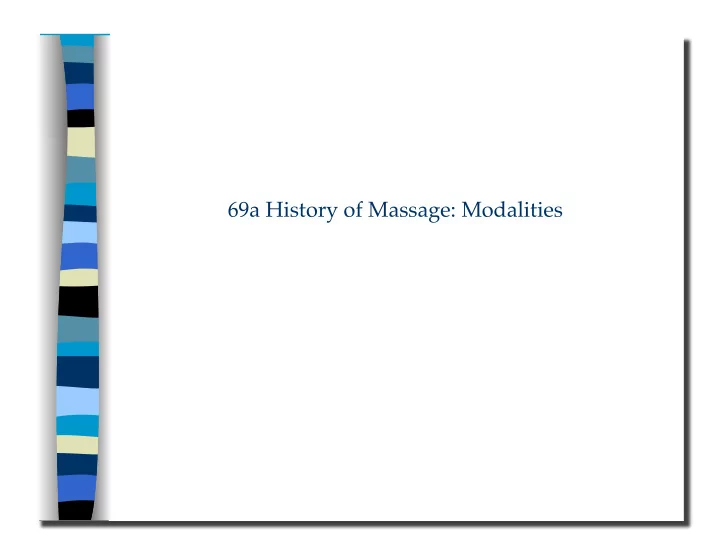

69a History of Massage: Modalities
69a History of Massage: Modalities � Class Outline 5 minutes Attendance, Breath of Arrival, and Reminders 10 minutes Lecture: 25 minutes Lecture: 15 minutes Active study skills: 60 minutes Total
69a History of Massage: Modalities � Class Reminders Special Reminder: 71b Sports Massage: Technique Demo and Practice – Pre-Event and Post-Event � – Please wear athletic clothing to this class. – You will be giving and receiving several 10-minute pre- and post-event massages in an athletic context Preparation for upcoming classes: 70a Written Exam (4 hours) � 70b Chair Massage, BMTs, Passive Stretches, and Side-lying Massage (30 minutes) � – Packet C: 11-12.
Classroom Rules Punctuality - everybody’s time is precious Be ready to learn at the start of class; we’ll have you out of here on time � Tardiness: arriving late, returning late after breaks, leaving during class, leaving � early The following are not allowed: Bare feet � Side talking � Lying down � Inappropriate clothing � Food or drink except water � Phones that are visible in the classroom, bathrooms, or internship � You will receive one verbal warning, then you’ll have to leave the room.
69a History of Massage: Modalities
Shiatsu Shiatsu Means “thumb pressure” in Japanese. � Tokujiro Namikoshi (1905-2000) was an early practitioner and teacher of shiatsu. � Uses generally the same anatomical/energy model as Chinese Medicine – meridians. �
Thai Massage Thai Massage Far older than shiatsu, Thai Massage can be linked back to early Buddhist yoga. � Uses similar ideas as meridians, but somewhat different language and somewhat different � “routes” and directions for the energy flow in the body.
Energy-based Therapies Reiki Japanese in origin. � Uses a model that one is channeling “Reiki energy”. � Can be done hands-on or hand-off. �
Energy-based Therapies Therapeutic Touch Hands-off, non-contact therapy. � Developed by Dolores Krieger and Dora Kunz in the 1970’s � Dolores Krieger was Professor Emerita of Nursing Science at New York University � Dora Kunz was a promoter of Theosophy and one-time president (1975-1987) of the � theosophical Society in America. NOTE: The goal of theosophy is to explore the origin of divinity, humanity and the world. �
Clinical Approaches within Massage Therapy Ben Benjamin Founder of the Muscular Therapy Institute in Cambridge, MA. � Author of Listen to your Pain and other books. � Disciple of James Cyriax, the orthopedic surgeon who systematized the assessment of injuries � and use of croww-fiber friction to help recovery be more thorough, speedier, and longer- lasting.
Neuromuscular Therapy Neuromuscular Therapy Judith Walker Delaney and Paul St. John are key to the development of NM therapy. � They developed trigger point work with a more elaborated theory for how the nervous � system is involved. This work drew on the work of Dr. Janet Travell and Dr. Nimmo (chiropractor). �
Sports and Orthopedic Massage Bob King 1948-2013. � Founder of Chicago School of Massage Therapy. � Also an early and important president of AMTA (American Massage Therapy Association). � Great teacher and promoter of Sports Massage. �
Sports and Orthopedic Massage Benny Vaughn Former athlete. � Certified Athletic Trainer and Strength and Conditioning Specialist. � World-renowned expert in training and massage for athletes. �
Sports and Orthopedic Massage Whitney Lowe Founder of OMERI (Orthopedic Massage Education & Research Institute). � Author of Orthopedic Massage and Orthopedic Assessment in Massage Therapy. �
Craniosacral Therapy William Sutherland 1873-1954. � Developer of cranial osteopathy. � Promoted healthy movement/alignment of cranial bones, meninges, and cerebrospinal fluid. � Dr. John Upledger (1932-2012) simplified Sutherland’s cranial osteopathy and began � marketing and teaching it in the 1970’s
Movement Therapies Milton Trager 1908-1997. � Trager method uses non-intrusive movements to promote better health, movement, and ease � in body and mind.
Movement Therapies Aston Patterning Developed by Judith Aston in 1977. � An educational process that combines coaching, movement coaching, bodywork, � ergonomics, and fitness training.
Movement Therapies Moshe Feldenkrais 1904-1984. � Feldenkrais method uses sloe, focused active or passive movements to undo dysfunctional � neurokinesthetic habits and replace them with more efficient ones.
Structural Integration Ida Rolf 1896-1979. � Developed “Structural Integration”, aka “Rolfing”. � Considered the “Einstein” of 20 th century bodywork. � Rolfing uses 10 sessions for restructuring the body by systematically repositioning the fascia. � “Gravity is the therapist”. �
Structural Integration Tom Myers Rolfer who developed a system for analyzing anatomy of fascia called Anatomy Trains. � His version of Rolfing is called Kinesis. �
Structural Integration Daniel Blake Rolfer who taught Rolfing the way Ida worked, not by the 10 session plan. � His version is called Structural Bodywork or Postural Kinesiology. �
Structural Integration Zero Balancing Developed by Fritz Smith, who is a Rolfer, a doctor, 5-element acupuncturist, and author of � two books: – Inner Bridges – Alchemy of Touch ZB promotes deep health through focus on the skeletal system’s structure and the energy � flowing through it.
69a History of Massage: Modalities
Recommend
More recommend